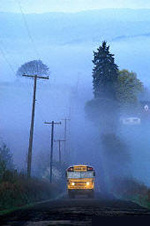
|
|||||
| Home | Register | Already Registered | |||
 |
Welcome Kristen Bauguess to DrivingUniversity.com |
Session 4 - Progress |
Page 1 of 11 Course Map Logout |
|
|
|
||
SESSION 4
This Session
contains the following topics:
DRIVING CONDITIONS Though Virginia is famous for its moderate climate, there are times when nature rebels and makes life difficult and dangerous. You need to be able to drive safely in all kinds of weather, under all types of road conditions. And even if the weather is perfect, your trip won’t be, if your vehicle should have mechanical problems. You need to know how to handle your vehicle in all kinds of hazards, both natural and man-made. You want to live to see the next beautiful day in the Old Dominion State!
FOG
When driving into a fog bank, reduce your speed, but keep moving. Horrendous pile-ups happen when just one driver rear ends a stopped car that he couldn't see until it was too late. Keep alert for slow moving vehicles in front of you, and frequently check your rearview mirror for cars that may be approaching too fast from behind. |

|

